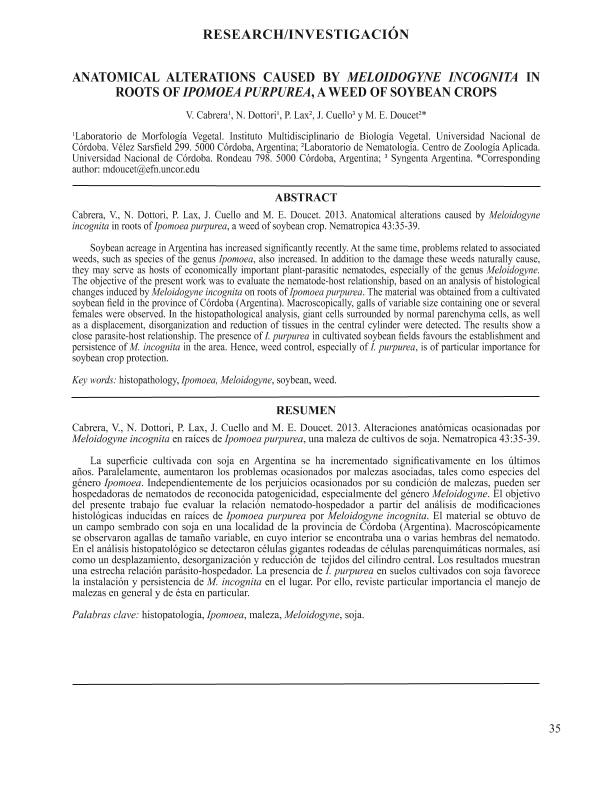Artículo
Soybean acreage in Argentina has increased significantly recently. At the same time, problems related to associated weeds, such as species of the genus Ipomoea, also increased. In addition to the damage these weeds naturally cause, they may serve as hosts of economically important plant-parasitic nematodes, especially of the genus Meloidogyne. The objective of the present work was to evaluate the nematode-host relationship, based on an analysis of histological changes induced by Meloidogyne incognita on roots of Ipomoea purpurea. The material was obtained from a cultivated soybean field in the province of Córdoba (Argentina). Macroscopically, galls of variable size containing one or several females were observed. In the histopathological analysis, giant cells surrounded by normal parenchyma cells, as well as a displacement, disorganization and reduction of tissues in the central cylinder were detected. The results show a close parasite-host relationship. The presence of I. purpurea in cultivated soybean fields favours the establishment and persistence of M. incognita in the area. Hence, weed control, especially of I. purpurea, is of particular importance for soybean crop protection. La superficie cultivada con soja en Argentina se ha incrementado significativamente en los últimos años. Paralelamente, aumentaron los problemas ocasionados por malezas asociadas, tales como especies del género Ipomoea. Independientemente de los perjuicios ocasionados por su condición de malezas, pueden ser hospedadoras de nematodos de reconocida patogenicidad, especialmente del género Meloidogyne. El objetivo del presente trabajo fue evaluar la relación nematodo-hospedador a partir del análisis de modificaciones histológicas inducidas en raíces de Ipomoea purpurea por Meloidogyne incognita. El material se obtuvo de un campo sembrado con soja en una localidad de la provincia de Córdoba (Argentina). Macroscópicamente se observaron agallas de tamaño variable, en cuyo interior se encontraba una o varias hembras del nematodo. En el análisis histopatológico se detectaron células gigantes rodeadas de células parenquimáticas normales, así como un desplazamiento, desorganización y reducción de tejidos del cilindro central. Los resultados muestran una estrecha relación parásito-hospedador. La presencia de I. purpurea en suelos cultivados con soja favorece la instalación y persistencia de M. incognita en el lugar. Por ello, reviste particular importancia el manejo de malezas en general y de ésta en particular.
Anatomical alterations caused by Meloidogyne incognita in roots of Ipomoea purpurea, a weed of soybean crop
Fecha de publicación:
06/2013
Editorial:
Organization Trop Amer Nematologists
Revista:
Nematropica
ISSN:
0099-5444
Idioma:
Inglés
Tipo de recurso:
Artículo publicado
Clasificación temática:
Resumen
Palabras clave:
Histopathology
,
Meloidogyne
,
Ipomoea
,
Soybean
,
Weed
Archivos asociados
Licencia
Identificadores
Colecciones
Articulos(IDEA)
Articulos de INSTITUTO DE DIVERSIDAD Y ECOLOGIA ANIMAL
Articulos de INSTITUTO DE DIVERSIDAD Y ECOLOGIA ANIMAL
Articulos(IMBIV)
Articulos de INST.MULTIDISCIPL.DE BIOLOGIA VEGETAL (P)
Articulos de INST.MULTIDISCIPL.DE BIOLOGIA VEGETAL (P)
Citación
Cabrera, Verónica Alejandra; Dottori, N.; Lax, Paola; Cuello, J.; Doucet, Marcelo Edmundo; Anatomical alterations caused by Meloidogyne incognita in roots of Ipomoea purpurea, a weed of soybean crop; Organization Trop Amer Nematologists; Nematropica; 43; 1; 6-2013; 35-39
Compartir




